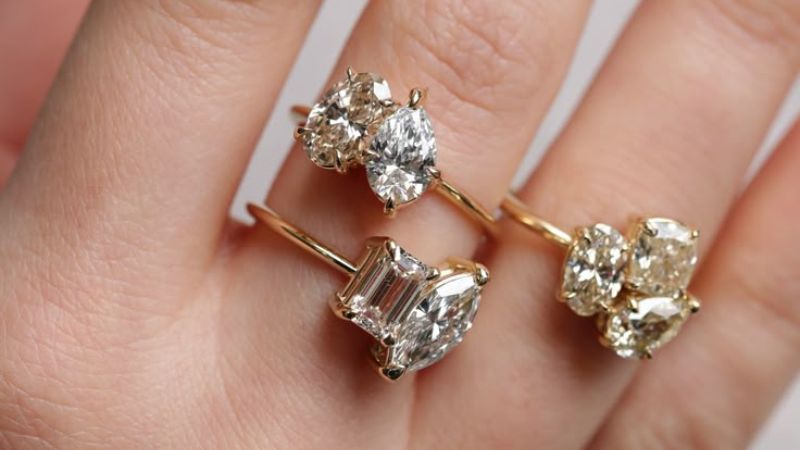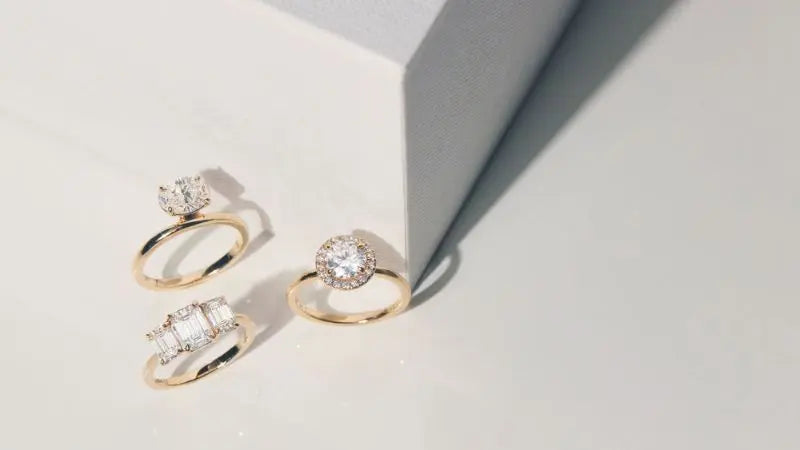Up To $2,500 OFF at checkout - Ends Dec 12
Free 30-day Returns | Lifetime Warranty
In this guide, we’ll dive deep into the anatomy, types, pros and cons, and maintenance tips for ring setting prongs to help you find the perfect setting for your engagement ring.
1. Introduction
Prong settings are a timeless choice for engagement rings, enhancing both security and brilliance. Their versatility accommodates various diamond shapes and sizes.
Understanding prong functionality helps you select the ideal setting for durability, aesthetics, and light reflection. This guide explores prong anatomy, types, benefits, drawbacks, and maintenance tips to ensure a lasting, radiant ring.

Prong settings
2. Anatomy of a Prong Setting
Diamond ring settings play a crucial role in both protecting and enhancing the beauty of your gemstone. Among them, the prong setting is a classic choice, loved for its ability to securely hold the diamond while allowing maximum light to pass through.

The anatomy of a prong ring setting

3. Types of Prong Settings
Different prong styles influence a ring’s durability, sparkle, and overall design.
3.1. Four-Prong Setting
A four-prong setting offers a minimalist, open look while securing the diamond with four evenly spaced prongs. It maximizes light entry, enhancing brilliance. However, fewer prongs mean slightly reduced security compared to a six-prong setting.

The Rachel round lab diamond ring with a four-prong setting
3.2. Six-Prong Setting
A six-prong setting enhances security by using two additional prongs to hold the diamond firmly in place. It is a preferred choice for round diamonds, especially in solitaire engagement rings.
The added prongs help distribute pressure evenly and provide extra protection against accidental impacts.

The 6-prong diamond engagement ring setting
3.3. Rounded Prong Setting
Rounded prongs resemble small dots when viewed from above, creating a delicate and refined look. Their design minimizes metal visibility while enhancing the diamond’s brilliance.

2.0-carat round-cut diamond ring with a rounded prong ring setting
This classic style is popular in engagement rings for its balance of security and light exposure.
3.4. V-Shape Prong Setting
Ideal for pointed diamonds such as marquise, pear, or princess cuts, the V-shape prong setting wraps around the stone’s delicate edges to prevent chipping.

The 1.5-carat princess-cut diamond ring with a V-shape setting
This setting is commonly used in rings with multiple diamonds, where shared prongs create a seamless and sophisticated appearance.
3.5. Claw Prong Setting
Claw prongs are elongated and tapered, securely gripping the stone while exposing more of its surface for maximum light reflection.

The Textured Twig round lab diamond ring
A petite claw prong offers an even subtler look but may reduce overall durability. This setting is ideal for those seeking a sleek, modern aesthetic with high brilliance.
3.6. Flat Prong Setting
Also known as the square or "tab" prong setting, this style provides a bold, geometric look. It is less common than round or claw prongs but adds a distinctive touch to contemporary ring designs.
Its broader surface area enhances durability while maintaining a secure hold on the diamond.

The 3-carat round-cut diamond ring with flat prongs on a ring
3.7. Double Prong Setting
Double prongs pair two prongs at each corner of the diamond, increasing stability and support. This setting is ideal for larger stones, as it helps distribute pressure evenly, reducing the risk of prong wear or diamond displacement over time.

The under twisted double prong solitaire engagement ring
3.8. Tulip Prong Setting
Inspired by nature, the tulip prong setting features petal-shaped prongs that cradle the diamond in a decorative, floral-inspired design. This setting adds a romantic and artistic touch while ensuring secure placement of the gemstone.

The solitaire petal Kamellie round lab diamond ring
4. Pros and Cons of Prong Settings vs. Other Settings
4.1. Advantages of Prong Settings
- Maximum Light Exposure: Prong settings allow more light to enter the diamond, enhancing its brilliance and fire.
- Minimal Metal Coverage: Unlike bezel settings, prongs cover less of the diamond, making it appear larger and more prominent.
- Classic and Timeless Appeal: A staple in engagement ring designs, prong settings have remained popular for generations.
- Versatility: Suitable for various diamond shapes and sizes, accommodating both traditional and modern ring styles.
4.2. Disadvantages of Prong Settings
- Risk of Snagging: Taller prongs may catch on fabrics or everyday objects, requiring cautious wear.
- Maintenance Requirement: Prongs can weaken or bend over time, necessitating periodic inspections and adjustments.
- Less Protection: Compared to bezel or halo settings, prongs provide minimal coverage, making diamonds more vulnerable to chipping or damage.
5. Top Prong Setting Rings in KNT Jewelry
KNT Jewelry offers a selection of finely crafted prong-set engagement rings, blending artistry with durability.
5.1. The Sofia
The Sofia is an elegant fusion of modern craftsmanship and timeless design. Its pavé-set diamonds along the band catch light effortlessly, while a scarf-shaped hidden halo enhances the center stone’s brilliance.

The Sofia Princess Lab Diamond Ring
Double prongs add extra security, making this ring perfect for those who appreciate refined yet striking details.
5.2. The Robin
Inspired by vintage and nature-inspired aesthetics, The Robin is an enchanting masterpiece. Ornate detailing and organic-shaped side stones elevate its charm.

The Robin radiant lab diamond ring
A gently sloping band cradles the center stone, while a hidden halo intensifies its radiance, creating a captivating effect.
5.3. The Skyler
Designed for the bold and modern bride, The Skyler makes a statement. Its semi-pavé band gracefully swirls around the center stone, claw-set in a basket and secured by a dynamic bypass setting. This innovative design merges elegance with contemporary sophistication.

The pave Skyler round lab diamond ring
5.4. The Penelope
The Penelope is a majestic split-shank halo engagement ring, exuding opulence and grandeur. Double diamond-set shoulders merge seamlessly into a radiant halo, amplifying size and brilliance.

The Miley pear lab diamond ring
Its regal design ensures an unforgettable presence on any occasion.
6. How to Maintain and Protect Your Prong Settings
To keep your prong-set engagement ring in pristine condition, follow these essential care tips:
- Avoid Strenuous Activities: Remove your ring before engaging in physical tasks like yard work, lifting heavy objects, or cleaning to prevent prong damage.
- Take Off Your Ring During Exercise: High-impact activities, including weightlifting, can weaken prongs over time.
- Schedule Regular Inspections: Have a professional jeweler examine your ring at least twice a year to ensure prong integrity and stone security.
- Perform Routine Checks: Inspect your ring for signs of wear, such as bent, shortened, or broken prongs. If the center stone appears loose, seek immediate professional maintenance to prevent potential loss or damage.
7. Conclusion
Prong settings provide the perfect balance of security, elegance, and brilliance. Whether you choose a four-prong, six-prong, or V-prong design, understanding the different styles ensures the best choice for your lifestyle. With proper care, a prong-set diamond ring remains a radiant and enduring symbol of love and commitment.
Looking for the perfect prong-set engagement ring? Explore KNT Jewelry’s exclusive collection to find a design that reflects your unique style!




